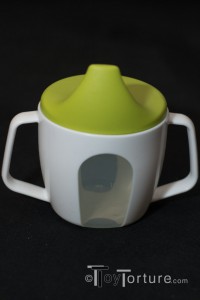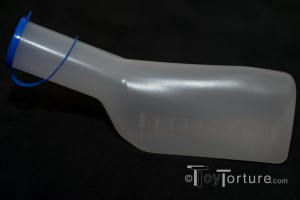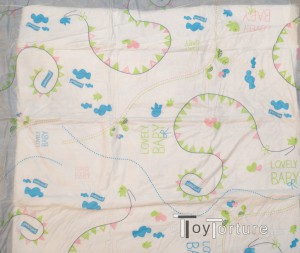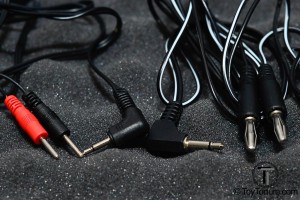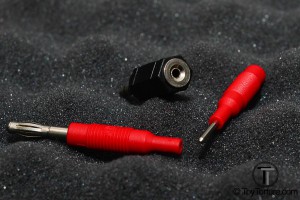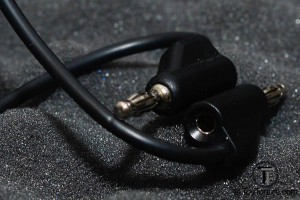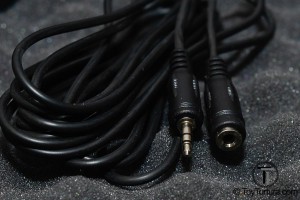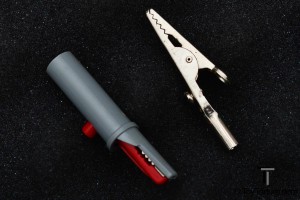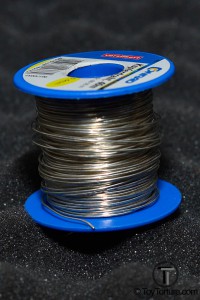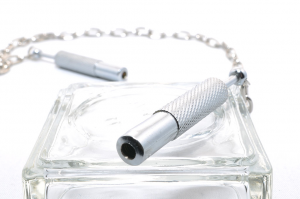TENS vs Shocks
There are two types of electric stimulation used for erotic pleasure and torture: TENS (short for transcutaneous electrical nerve stimulation) and shocks. While shock devices like a violet wand or stun guns interacts with the skin, TENS units send electric stimulation through the body in order to stimulate the nerve endings. Both kinds of play have different safety and usage aspects to keep in mind when playing. This article is only about TENS units. While both kind of play are called e-stim I will use the term e-stim in this article as a synonym for TENS play.

Detail of the Inputs and Outputs of the Erostek ET232
How does E-Stim work?
In order to create a sensation you need at least two electrodes with different poles that don’t touch each other and are connected to one channel on a power unit. This unit generates electric impulses onto which usually wave patterns are modulated. These impulses travel from one electrode to another and stimulate the nerves in the area roughly around the electrode. Due to the way nerves are distributed throughout the body and the way they transmit information it is possible that the stimulation can be felt elsewhere, p.e. in your glans even though the electrodes are around the balls and the penis root. The sensation is felt stronger at the electrode with the lower the mass and/or the smaller contact area. If the difference between the electrodes is very large (p.e. using a big anal monopole and a small silicone loop) it is possible that the sensation is only felt at the smaller pole. Generally speaking it can be said the larger the mass and the surface area covered, the smoother the sensation feels yet the more power is needed to produce agonizing sensations.
Safety rules
Generally speaking E-Stim play is not more dangerous than any other form of BDSM as long as you stick to some basic safety rules:
- Do not use electric stimulation if you have any electronic medial device implanted like a pacemaker! The stimulating impulses of the e-stim box can cause male function or destroy the device which can be lethal!
- If you have any illnesses affecting your nerve system or heart, talk to your doctor where electro stimulation is possible.
- Use only devices which put out AC! There are power boxes out there for medical purposes which run on DC. They are only made to be used by experienced medical personal for medical purposes and NOT FOR PLEASURE! In a nut shell: The impulses of a DC currency will affect the cellular and molecular electrolysis. So the effects of letting DC run through your body are:
- Denaturation of proteins
- Destruction of cell membranes
- Accumulation of metal salts in your body
- Blood clotting at the anode, blood thinning at the cathode
- Ultimately poisoning and necrosis
- Unpleasant, burning sensation through static nerve stimulation
-

E-Stim System Monopolar Pin Wheel
Don’t let currency run over the chest! I am aware that this is a controversial topic because people claim it is safe as long as you use electrodes on the surface because currency always takes the shortest path. This assumption is dangerous! Currency always takes the path of the lowest resistance which usually is the shortest way but needn’t be necessarily. If through a form of day your skin transmits currency very badly yet there is a concentration of a very good conducting body fluid it will take this way even if your heart is in the way. Muscles are triggered by electric impulses and thus can also be affected by E-Stim. Your heart is one big muscle and exposing it to E-Stim can be fatal! The effect needn’t occur instantly; cardiac dysrhythmia can occur days after your heart being exposed to E-Stim impulses! So I strongly advise you to ere on the side of caution and:
- Play below the waist freely
- Place both electrodes on the same arm when stimulating this body area
- If interested in nipple play, use ONLY BIPOLAR electric clamps and use a box with COMPLETELY ISOLATED CHANNELS
- Only use toys there are in perfect condition and fully functional! This should be natural and apply to all toys used but especially when E-Stim malfunctions it can produce very nasty effect. If something doesn’t work as expected don’t try to fix it during the scene but do something else and investigate when you have time and are not horny anymore.
- Be aware of unintended results of the stimulation especially when triggering large muscles! As I have written above muscle functions are triggered by electric impulses. So stimulation can trigger an unexpected and hard muscle function; I have seen subs involuntary rip restraints apart so play with a bit of caution.
- I generally recommend only to use your power box on battery. This limits the bad effects when something goes wrong to the voltage of the battery (mostly 9V) which might be extremely unpleasant but not dangerous.
- As a top never touch the both poles at the same time when not wearing protective (= isolating) gear. Currency usually takes the path lowest resistance which most of the time is the shortest and thus will most of the time run through the sub. However, there are configurations possible where the top get shocked and if the heart is in the way he will get exposed to the dangerous described above!
How to play
Electro play is a delicate play where only a little further twist of the knob can mean the difference between agony and ecstasy. So here are some guide lines I found sticking to useful.

Ready-to-Play Set-Up of an inexpensive E-Stim Device
When preparing a sub for play I attach the leads to the electrodes, than put the electrodes onto or into the sub. Than I make sure that all channels are completely turned off, connect the box with the power source and than check again if the channels are off again. After I that plug the leads into the power box. Just for security reasons I prefer to run the boxes just on (the internal) batteries because they are limited to 9V (resp. 12V with the ET312b’s internal battery). It is highly unlikely that the PSU will malfunction but I prefer to ere on the side of caution.
When starting the stimulation I would recommend slowly increasing the intensity until the sub starts feeling a slight tingle. Depending on the form of day (p.e. the amount of sweat on the skin), the electrode and power box used, the body area where the electrodes are put onto and the program selected the intensity level needed to create a recognizable sensation can vary. So there is no general rule from which intensity level to start with. The same applies for breaks: A level that brought out the grunting horny pain pig might be excruciating even after a short break because the body’s pain memory and processing system calm down quite quickly. So after every break ease the sub into the sensation and stimulation level again. While the area in the brain which transforms pain into pleasure forgets quickly your nerves don’t. Thus it is normal to feel some buzzing sensation in the area where the electrode was placed for quite some time even after the electrode has been removed. This sensation can last for minutes up to hours.
If something goes wrong DON’T FIDDLE WITH THE BOX! Just pull the leads out of the box! Once no currency flows anymore the sensation stops!
What do you need to play
In order to create a sensation, you need a power box that creates the impulses, leads for connecting the box to the electrode and at least two poles in form of electrodes.
Power boxes
The power box is an electrical device that converts the DC which comes out of the power adaptor or the battery into AC. Inside the box is an amplifier which creates a pulsed electric pulse; a continuous pulse is rarely used because you can’t feel the difference but the battery would get drained more quickly. Onto these pulses a wave form is modulated. These are the patterns which are called programs and are the basis for an interesting stimulation.

The Erostek ET232, an analogue E-Stim Box with two channels
Good power boxes have an amplifier for each channel. I would always recommend getting a box with isolated channels because not only do you have the full power on each channel at your hand but if your box is not faulty there is no unintended interaction between the channels. This is especially important when the heart lies between the electrode pairs. Most boxes have two channels which I find the most useful because you can stimulate the ass and the dick p.e. at the same time. There are inexpensive boxes out there with only one channel which are a good compromise for beginners. There are also boxes out there with four channels but I would not recommend them because they are difficult to operate.
Power boxes come with analogue and digital wave form modulators. There is no general saying which is better. Due to the form factor of the boxes made for erotic stimulation digital boxes most of the time allow more and complex manipulations. Depending on their processor their waves can feel a bit chiseled because they are only able to create stairs-like wave patterns and boxes with little processor power create large “steps”. Having a digital generated wave pattern enables accordingly programmed power boxes to end the wave pattern after one wave has been produced. This comes in handy if you want to train someone by letting him experience only a single wave. However digital boxes tend to be more expensive, especially the ones with more sophisticated setup options like the Erostek 312b or E-Stim System 2b. So I would recommend starting out with an analogue box and if you start to feel the limitations of the box in your play upgrade to a bigger box.
Some power boxes come equipped with an additional interface. The most common ones are an audio interface either through a line-in and/or a microphone or a shock sensor. Especially in combination with another box you can create evil setup (p.e. the louder the sub screams from stimulation of one box the stronger fires the other one and he can only break out of the circle when he gets a grip on himself).
Connection systems
There are two major systems for connection leads: 2.5mm audio plug onto 2mm pin used p.e. by MyStim, Zeus, Rimba, P.E.S. and most medical devices for home usage and 3.5mm audio plug onto 4mm banana plug which is used by ErosTek and E-Stim Systems p.e.. When starting your E-Stim toy collection I would recommend choosing one system for which you buy your leads and use adapters to incorporate toys from the other system into your play setup. Theoretically it doesn’t matter which system you choose. Practically I would advice you to use 3.5mm audio onto 4mm banana plug because it is the professional industry standard used p.e. for lab equipment. So most pervertables and inexpensive leads, adapters and splitters are based on this system. If you have a box from the other system buy 2.5mm onto 3.5mm adapters.
Electrodes
Electrodes can be divided in two categories: Surface electrodes and insterable ones.

The HML Bi-Polar E-Stretcher
Surfaces Electrodes
This kind of electrodes are used on the skin. Nowadays nearly every sex or BDSM toy comes in an electrified variety so you can get paddels, chastity cages, clamps, pin wheels, restraints, gloves, penis sheaths, ball crusher, humbler, cock & glans rings and ball stretchers as electrodes. Besides these erotic toys pervertables like electro pads originally made for medical purposes, modified anti-static bands or my beloved conductive silicone loops fall into this category.
Most surface electrodes usually have a limited mass and contact area so they mostly create a stingy sensation. Keep this in mind when choosing your toys: Some might look that they are great for tingling sensation play but the effect might be agonizing. Another attribute the majority of surface electrodes share are that they are monopoles by design. So when incorporating them into your play use them in pairs or combine them with another electrode or a bipolar one using a tri-phase cable. When doing so keep in mind that the direct path mustn’t cross the heart!

Three E-Stim System Bi-Polar Electro Plugs
Insertables
I call all electrodes which are designed to be put into the body insertables. They come in two varieties:
- Plugs and dildos: They are made to be shoved up the ass (and for the few female readers also the vagina). There are a few monopoles out there which require a second electrode in order to work. But most plugs and dildos are bi-poles which also come in two varieties: One where the two poles are separated horizontally. With the right program they can create a fucking sensation. The other variety has the poles separated vertically. I haven’t experienced a quality electrode of this kind yet (the one I had was so crappy I won’t take the sensation as a reference) so I can’t really tell how the sensation will be. If you want to provide me with a review sample I would be very happy.
- Sounds: Designed to be put into the sensitive urethral they create a very intense sensation. They come in a great number of varieties: Mostly they are monopoles but there are also bi-polare versions out there, some are smooth, others are structured for an additional stimulation. Like when playing with non-electrical sounds it is paramount that the sounds are disinfected before play and used with sterile water based lube! Do not use special conductive gel (see next paragraph!). Also the surface must be flawless in order to prevent injuries!
Conductive Lube
In order to transfer the stimulation from the electrode onto the body there has to be a conductive medium between the electrode and the nerves. Since the body consists of a quite high amount of salt conductivity inside the body is no problem. However on the skin there is only a limited amount of salt from sweat, etc. Since these accumulations of salt are usually very concentrated the currency will flow only in limited areas leading to a stingy and quite strong stimulation. In order to prevent this you can use conductive solutions. There are special electro gels out there which are in my opinion a waste of money. Every water based lube which contains glycerin will work perfectly. I have conducted a blind test between conductive gel, Swiss Navy water based lube, ID Glide water based lube, Elbow Grease H2O and Aqua Glide and none of the probands noticed a difference. There are special sticky conductive lubes out there for attaching surface electrodes to the body. They provide some level of adhesion but they are designed for still sitting patients. Since your sub is probably going to be a bit more active I recommend saving the money on these special products, use normal water based lube together with adhesive tape.
I hope I have covered the most interesting and burning questions when starting electro play. If you have any questions, additions or suggestions please send men an e-mail.






